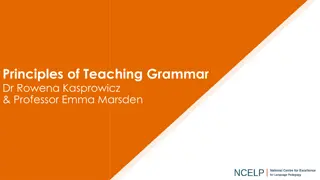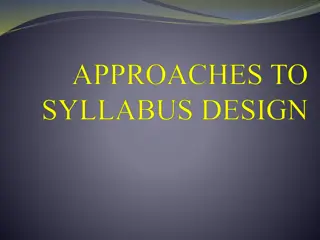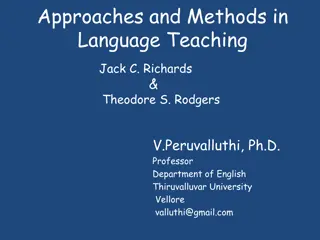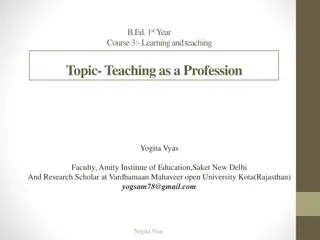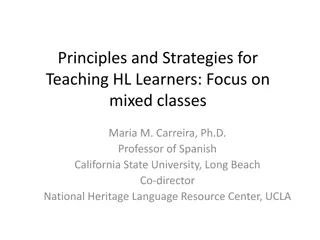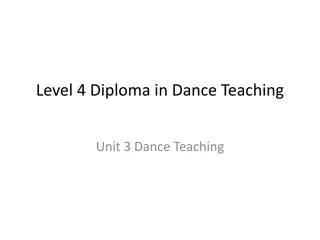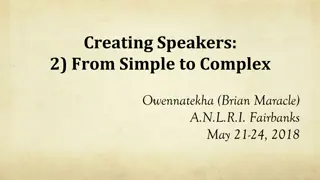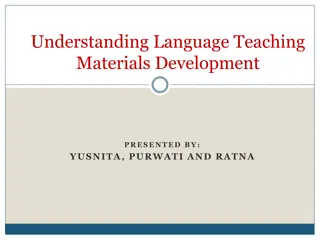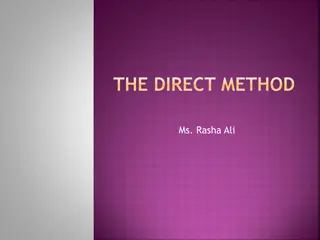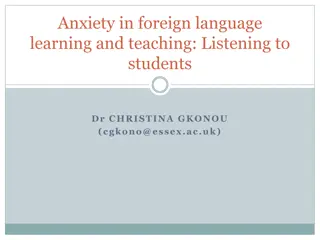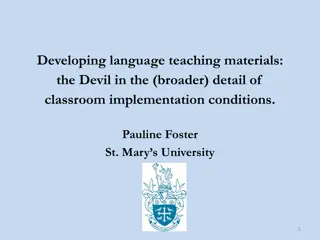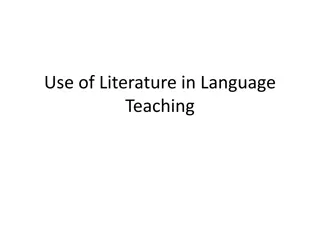Language Teaching Approaches Overview
Various language teaching methods such as PPP (Presentation, Practice, Production), TBL (Task-based Learning), TPR (Total Physical Response), and CLIL (Content and Language Integrated Learning) are explored in this document. The PPP method involves three stages - presentation, practice, and production, while TBL focuses on meaningful tasks to develop fluency and confidence. Principles behind TBL emphasize task-oriented language learning for students.
Download Presentation

Please find below an Image/Link to download the presentation.
The content on the website is provided AS IS for your information and personal use only. It may not be sold, licensed, or shared on other websites without obtaining consent from the author.If you encounter any issues during the download, it is possible that the publisher has removed the file from their server.
You are allowed to download the files provided on this website for personal or commercial use, subject to the condition that they are used lawfully. All files are the property of their respective owners.
The content on the website is provided AS IS for your information and personal use only. It may not be sold, licensed, or shared on other websites without obtaining consent from the author.
E N D
Presentation Transcript
: 21 1-12 2016 . . , . : - .
Different approaches to language presentation - PPP (Presentation, Practice, Production) ; - TBL (Task-based learning; - TPR (Total Physical Response); - TTT (Test-Teach-Tes ); - CLIL/content and language integrated learning/; - Blended Learning.
PPP (Presentation, Practice, Production) The PPP method could be characterized as a common-sense approach to teaching as it consists of 3 stages. The first stage is the presentation of an aspect of language in a context that students are familiar with, much the same way that a swimming instructor would demonstrate a stroke outside the pool to beginners. The second stage is practice, where students will be given an activity that gives them plenty of opportunities to practice the new aspect of language and become familiar with it whilst receiving limited and appropriate assistance from the teacher. To continue with the analogy, the swimming instructor allowing the children to rehearse the stroke in the pool whilst being close enough to give any support required and plenty of encouragement. The final stage is production where the students will use the language in context, in an activity set up by the teacher who will be giving minimal assistance, like the swimming instructor allowing his students to swim themselves. Watch the video: <iframe width="560" height="315" src="https://www.youtube.com/embed/RLWTuauUrKo" frameborder="0" allowfullscreen></iframe>
Are all P`s equal? presentation practice production
TBL (Task-based learning) TBL focuses on the use of authentic language and on asking students to do meaningful tasks using the target language. Such tasks can include visiting a doctor, conducting an interview, or calling customer service for help. Assessment is primarily based on task outcome (in other words the appropriate completion of real world tasks) rather than on accuracy of prescribed language forms. This makes TBLT especially popular for developing target language fluency and student confidence. TBLT was popularized by N. Prabhu while working in Bangalore, India. Prabhu noticed that his students could learn language just as easily with a non-linguistic problem as when they were concentrating on linguistic questions. Watch the video: https://youtu.be/T5b9gHSPiB8
Principles behind TBL(Task based learning): Classwork is organized as a sequence of tasks; Tasks generate the language to be used, not vice versa; Main focus on final task to be done. https://youtu.be/CxNq2Hsz 3Ic
TPR (Total Physical Response) TPR is a language teaching method developed by James Asher, a professor of psychology at San Jos State University. It is based on the coordination of language and physical movement. In TPR, instructors give commands to students in the target language, and students respond with whole-body actions. The method is an example of the comprehension approach to language teaching. The listening and responding (with actions) serves two purposes: It is a means of quickly recognizing meaning in the language being learned, and a means of passively learning the structure of the language itself. Grammar is not taught explicitly, but can be learned from the language input. TPR is a valuable way to learn vocabulary, especially idiomatic terms, e.g., phrasal verbs.
Asher developed TPR as a result of his experiences observing young children learning their first language. He noticed that interactions between parents and children often took the form of speech from the parent followed by a physical response from the child. Asher made three hypotheses based on his observations: first, that language is learned primarily by listening; second, that language learning must engage the right hemisphere of the brain; and third, that learning language should not involve any stress. Total physical response is often used alongside other methods and techniques. It is popular with beginners and with young learners, although it can be used with students of all levels and all age groups. Watch the video: https://youtu.be/1Mk6RRf4kKs
CLIL/content and language integrated learning/ This kind of approach has been identified as very important by the European Commission because: "It can provide effective opportunities for pupils to use their new language skills now, rather than learn them now for use later. It opens doors on languages for a broader range of learners, nurturing self-confidence in young learners and those who have not responded well to formal language instruction in general education. It provides exposure to the language without requiring extra time in the curriculum, which can be of particular interest in vocational settings. This approach involves learning subjects such as history, geography or others, through an additional language. It can be very successful in enhancing the learning of languages and other subjects, and helping children develop a positive attitude towards themselves as language learners.
Blended Learning http://www.slideshare.net/EmilySchmidt317/nc-ties-presentation-blended-learning-2
Games-zip, zap, zop Icebreaker Purpose - Energy Boost The goal of this game to pass an imaginary relay baton( ) around the group for as long as possible without letting it drop. To make things difficult, the relay baton can only be passed using the instructions "Zip", "Zap" or "Zoom". Zip = pass the relay baton in the same direction of travel. Zap = change the direction of travel of the relay baton. Zoom = jump the relay baton to anybody by keeping eye contact. The group stands in a circle and the relay baton is passed around using the "Zip", "Zap" or "Zoom" instructions. Failing to do so, and the relay baton would fall. The stop watch would start from zero, and so on.... Passing the relay baton must be with lots of body movement and hand gestures. Watch the video:https://youtu.be/t-7jmkiSKUk




